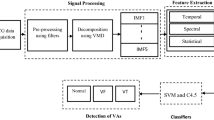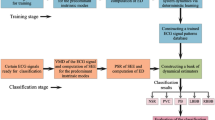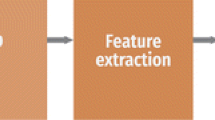Abstract
An Electrocardiography (ECG) signals, which represent the electrical activities of a human heart and provide data on its function and diseases, are crucial for the diagnosis of cardiac disorders and the identification of arrhythmias. The empirical mode decomposition (EMD) is extensively used for the classification of heart signal, although there are limitations such as noise sensitivity and sampling. In this paper, variational mode decomposition (VMD) is adopted for the extraction of features based on distinct intrinsic mode functions (IMFs). The features are fed to support vector machine (SVM) classifier with radial basis function (RBF) kernel. The VMD algorithm was implemented in Matlab and the SVM was trained with 80% data. A test accuracy of 95% was obtained from the classifier which classifies the data into normal or abnormal. This work can be applied for precise diagnosis of arrhythmia.
Access this chapter
Tax calculation will be finalised at checkout
Purchases are for personal use only
Similar content being viewed by others
References
Nazari M, Sakhaei SM (2015) An efficient method for extracting respiratory activity from single-lead-ECG based on variational mode decomposition. In: 2015 22nd Iranian conference on biomedical engineering (ICBME), pp 194–198. https://doi.org/10.1109/ICBME.2015.7404141
Lahmiri S, Boukadoum M (2014) Biomedical image denoising using variational mode decomposition. In: 2014 IEEE biomedical circuits and systems conference (BioCAS) proceedings, pp 340–343. https://doi.org/10.1109/BioCAS.2014.6981732
Maji U, Pal S (2016) Empirical mode decomposition vs. variational mode decomposition on ECG signal processing: a comparative study. In: 2016 international conference on advances in computing, communications and informatics (ICACCI), pp 1129–1134. https://doi.org/10.1109/ICACCI.2016.7732196
Choudhary T, Sharma LN, Bhuyan MK (2018) Standalone heartbeat extraction in SCG signal using variational mode decomposition. In: 2018 international conference on wireless communications, signal processing and networking (WiSPNET), pp 1–4. https://doi.org/10.1109/WiSPNET.2018.8538723
Villa A, Padhy S, Willems R, Van Huffel S, Varon C (2018) Variational mode decomposition features for heartbeat classification. In: 2018 computing in cardiology conference (CinC), pp 1–4. https://doi.org/10.22489/CinC.2018.231
He W et al (2018) Variational mode decomposition-based heart rate estimation using wrist-type photoplethysmography during physical exercise. In: 2018 24th international conference on pattern recognition (ICPR), pp 3766–3771. https://doi.org/10.1109/ICPR.2018.8545685
Mert A (2016) ECG signal analysis based on variational mode decomposition and bandwidth property. In: 2016 24th signal processing and communication application conference (SIU), pp 1205–1208. https://doi.org/10.1109/SIU.2016.7495962
Gopika P, Sowmya V, Gopalakrishnan EA, Soman KP (2020) Transferable approach for cardiac disease classification using deep learning, chap 12. In: Agarwal B, Balas VE, Jain LC, Poonia RC, Sharma M (eds) Deep learning techniques for biomedical and health informatics. Academic Press, pp 285–303. ISBN 9780128190616. https://doi.org/10.1016/B978-0-12-819061-6.00012-4
Aswani AR, Shanmughasundaram R (2022) Fault diagnosis using VMD and deep neural network. In: Chen JIZ, Wang H, Du KL, Suma V (eds) Machine learning and autonomous systems. Smart innovation, systems and technologies, vol 269. Springer, Singapore. https://doi.org/10.1007/978-981-16-7996-4_41
Anusha S, Sriram A, Palanisamy T (2016) A comparative study on decomposition of test signals using variational mode decomposition and wavelets. Int J Electr Eng Inform 8:886–896
Sujadevi VG, Mohan N, Sachin Kumar S et al (2019) A hybrid method for fundamental heart sound segmentation using group-sparsity denoising and variational mode decomposition. Biomed Eng Lett 9:413–424. https://doi.org/10.1007/s13534-019-00121-z
Author information
Authors and Affiliations
Corresponding author
Editor information
Editors and Affiliations
Rights and permissions
Copyright information
© 2023 The Author(s), under exclusive license to Springer Nature Singapore Pte Ltd.
About this chapter
Cite this chapter
Gautam, S., Shanmughasundaram, R. (2023). Classification of Heart Signal Using Variational Mode Decomposition. In: Kaiser, M.S., Xie, J., Rathore, V.S. (eds) Information and Communication Technology for Competitive Strategies (ICTCS 2022). Lecture Notes in Networks and Systems, vol 615. Springer, Singapore. https://doi.org/10.1007/978-981-19-9304-6_62
Download citation
DOI: https://doi.org/10.1007/978-981-19-9304-6_62
Published:
Publisher Name: Springer, Singapore
Print ISBN: 978-981-19-9303-9
Online ISBN: 978-981-19-9304-6
eBook Packages: EngineeringEngineering (R0)




